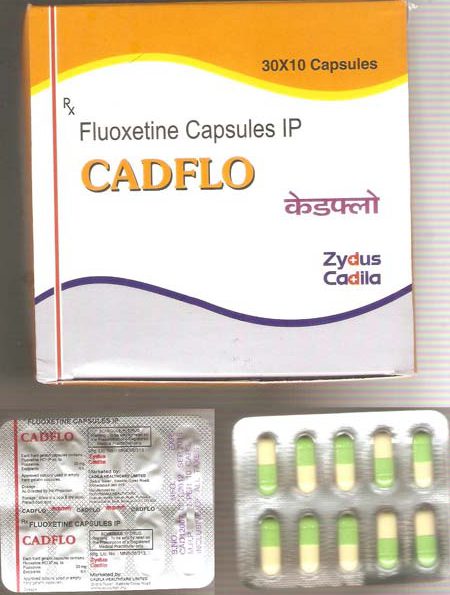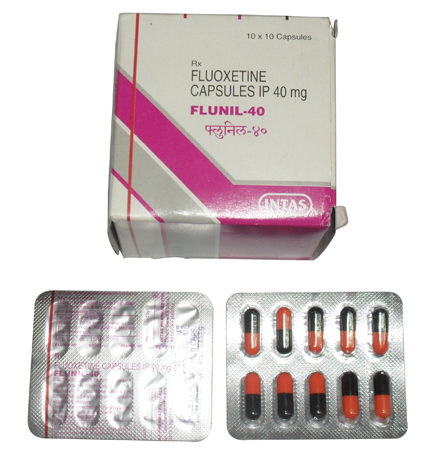Safety & Guarantee to United Kingdom, United States, Australia!
| Active substance | Fluoxetine (C17H18F3NO) |
| Trade names | Prozac, Sarafem, Adofen |
| IN Brand | Cadflo, Flunil |
| Manufacturing by | Intas, Cadila |
| Strength | 20mg / 40mg |
| Form release | Blister 10 capsules |
| Shipping time | 7 – 18 days (Depending from the Country) |
| Availability & Order | through request form |
Fluoxetine is frequently used to treat major depressive disorder, obsessive-compulsive disorder (OCD), post-traumatic stress disorder (PTSD), bulimia nervosa, panic disorder, premenstrual dysphoric disorder, and trichotillomania. It has also been used for cataplexy, obesity, and alcohol dependence, as well as binge eating disorder. It has also been tried as a treatment for autism spectrum disorders with moderate success in adults.
Depression
NICE recommends antidepressant treatment with an SSRI in combination with psychosocial interventions as second-line treatment for short term mild depression, and as a first line treatment for severe and moderate depression, as well as mild depression that is recurrent or long-standing. The American Psychiatric Association includes antidepressant therapy among its first-line options for the treatment of depression, particularly when “a history of prior positive response to antidepressant medications, the presence of moderate to severe symptoms, significant sleep or appetite disturbances, agitation, patient preference, and anticipation of the need for maintenance therapy” exist.
Obsessive-compulsive disorder
The efficacy of fluoxetine in the treatment of obsessive-compulsive disorder (OCD) was demonstrated in two randomized multicenter phase III clinical trials. The pooled results of these trials demonstrated that 47% of completers treated with the highest dose were “much improved” or “very much improved” after 13 weeks of treatment, compared to 11% in the placebo arm of the trial. The American Academy of Child and Adolescent Psychiatry state that SSRIs, including fluoxetine, should be used as first-line therapy in children, along with cognitive behavioral therapy (CBT), for the treatment of moderate to severe OCD.
Panic disorder
The efficacy of fluoxetine in the treatment of panic disorder was demonstrated in two 12-week randomized multicenter phase III clinical trials that enrolled patients diagnosed with panic disorder, with or without agoraphobia. In the first trial, 42% of subjects in the fluoxetine-treated arm were free of panic attacks at the end of the study, vs. 28% in the placebo arm. In the second trial, 62% of fluoxetine treated patients were free of panic attacks at the end of the study, vs. 44% in the placebo arm.
Bulimia nervosa
A 2011 systematic review of seven trials which compared fluoxetine to a placebo in the treatment of bulimia nervosa; six of which found a statistically significant reduction in symptoms such as vomiting and binge eating. However, no difference was observed between treatment arms when fluoxetine and psychotherapy were compared to psychotherapy alone.
Sexual dysfunction
Sexual dysfunction, including loss of libido, anorgasmia, lack of vaginal lubrication, and erectile dysfunction, is one of the most commonly encountered adverse effects of treatment with fluoxetine and other SSRIs. While early clinical trials suggested a relatively low rate of sexual dysfunction, more recent studies in which the investigator actively inquires about sexual problems suggest that the incidence is >70%.Symptoms of sexual dysfunction have been reported to persist after discontinuing SSRIs, although this is thought to be occasional.
The usual doses are:
- Depression: the recommended dose is 20 mg daily. Your doctor will review and adjust your dosage if necessary within 3 to 4 weeks of the start of treatment. When appropriate the dosage can be gradually increased up to a maximum of 60 mg. The dose should be increased carefully to ensure that you receive the lowest effective dose. You may not feel better immediately when you first start taking your medicine for depression. This is usual because an improvement in depressive symptoms may not occur until after the first few weeks. Patients with depression should be treated for a period of at least 6 months.
- Bulimia nervosa: the recommended dose if 60 mg daily.
- Obsessive-compulsive disorder (OCD): the recommended dose is 20 mg daily. Your doctor will review and adjust your dosage if necessary after 2 weeks of treatment. When appropriate the dosage can be gradually increased up to a maximum of 60 mg. If no improvement is noted within 10 weeks, treatment with Fluoxetine should be reconsidered.
- Children and adolescents aged 8 to 18 years with depression: treatment should be started and be supervised by a specialist. The starting dose is 10 mg/day (given as 2.5 ml of fluoxetine oral liquid). After one to two weeks, your doctor may increase the dose to 20 mg/day. The dose should be increased carefully to ensure that you receive the lowest effective dose. Lower weight children may need lower doses.
Your doctor should review the need for continuing treatment beyond 6 months. If you have not improved, your treatment should be reassessed.
If you are elderly, your doctor will increase the dose with more caution and the daily dose should generally not exceed 40 mg. The maximum dose is 60 mg per day.
If you have a liver problem or are using other medication that might have an influence on fluoxetine, your doctor may decide to prescribe a lower dose or instruct you to Fluoxetine every other day.
Common side effects include trouble sleeping, loss of appetite, dry mouth, rash, and abnormal dreams. Serious side effects include serotonin syndrome, mania, seizures, an increased risk of suicidal behavior in people under 25 years old, and an increased risk of bleeding. If stopped suddenly a withdrawal syndrome may occur with anxiety, dizziness, and changes in sensation.
It is unclear if it is safe in pregnancy. If already on the medication it may be reasonable to continue during breastfeeding.
Its mechanism of action is not entirely clear but believed to be related to increasing serotonin activity in the brain.

